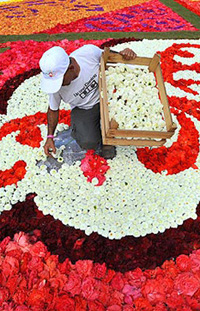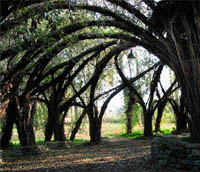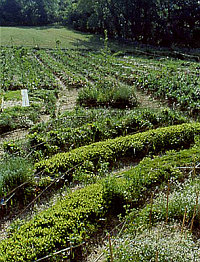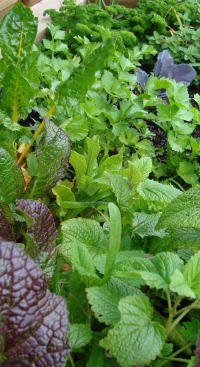
Amazing things you can do with 500,000 dahlias.
There are new White House kitchen garden videos.
Edible Geography has a day out with mushrooms grown in an old railway tunnel.

Amazing things you can do with 500,000 dahlias.
There are new White House kitchen garden videos.
Edible Geography has a day out with mushrooms grown in an old railway tunnel.
Inspired by Geoff Lawton’s Establishing a Food Forest, a group has got together to explore the potential of food forest gardening on the Kapiti Coast. Our vision is to build a community food forest garden for Kapiti.
Planned, planted and maintained by the community, the forest garden will serve as an education resource, plant nursery, seed bank, outdoor community centre, meeting point and food bank. Accessible to all, the area will become an edible landscape with walkways and glades, natural in look but designed with our needs for sustenance and play. A living repository for the future, in the heart of our community.
We’ve been doing a lot of talking, thinking, researching and come up with a document that we think encompasses the project’s heart. Now, we need some input and some support from you.
Have a read of the Kapiti Community Food Forest Proposal
Please do send us an email answering the following questions:
1. Do you support in principle the establishment of a community food forest in Kapiti?
2. Would you be willing to be part of a group of volunteers that is responsible for the establishment and maintenance of a Kapiti community food forest ?
3. Do you have any resources (land or money) you would be willing to donate to help to establish the Kapiti community food forest?

See the rest of this incredible photo article at Dark Roasted Blend
Ive just been reminded of a New Zealand short film I saw awhile ago. An Indian woman paints the story of spices onto the back of her lover. It’s just over 8 minutes and well worth a look. Enjoy!
(Contains some scenes with naked flesh – if you are averse to such things please look away)
[youtube=http://www.youtube.com/watch?v=6Z3XMRrKOug]

I have to admit, I’ve become a little obsessed by these beautiful beds, all curved and mounded in sweeping lines. I also love the very way they are constructed, in sort of gentle sweeping movements. Due to my terrain I’m not able to do them at my house, so I’ve been eyeing up other people’s gardens to work on.
Anyway, here are notes on the video including links to some other pieces on Emilia…
Based on work of Masanobu Fukuoka, The One Straw Revolution. 1978. Rodale.
Need to modify systems to our own location. Want to get high-yields whiile maintaining the soil’s own fertility.
No cultivation
No chemical or organic fertilisers
No chemical treatments
No compaction of the soil
Set out beds with sticks and then clear paths for your feet, mounding the soil into beds. Mounds should be 4 feet wide with 20 inches for the path. 10 – 30 inches for the beds deeper the beds the more room for the roots. Give them any shape you wish but make sure you can reach the centre of the beds easily.
Sheet mulch – cover the ground with cardboard. A good way to clear ground and you can grow potatoes at the same time.
Plants synthesise from light. Plants only take 2.5% of their mass from the soil. The rest comes from air and light. Plants give back much more to the soil then they take out.
Use marigolds all through the garden.
Beans and peas are legumes and fix nitrogen into the soil. You can use ash, which contains potash, to help grow your beans. This provides free fertiliser for your soil, the bacteria providing many benefits to your plants. These plants will also provide a living mulch between your plants. After harvest, the plants can simply be cut off, leaving the roots in the soil. the plant matter can simply be left on top of the beds. providing further mulch.
Synergistic gardening uses compost in the greenhouse or flats to start the plants – it doesn’t ‘force feed’ your soil with it.
Onions, garlic and leeks can be planted on the side of the garden beds. They function as pests controllers as well as being nutritious. They can be intermixed with other plants like lettuce or swiss chard.
Many plants reseed themselves – an advantage of letting plants finish their life cycle.
Mulching the mounds – Newspaper, cardboard, straw, leaves, wool. You can use grass clippings as mulch, but make sure you cut it and let it dry before it starts to seed. The first year the soill will be eating the mulch but as the organic contents in the soil improves, the amount of mulch needed will reduce. You will still need to weed, but it will gradually reduce – it’s all part of the evolving cycle.
Ducks (Indian Runner ducks), some birds, hedgehogs, lizards all eat slugs. Copper cuffs, or ones made from coke cans can protect plants from slugs.
When harvesting plants like lettuce, cut above the ground allowing the plant a chance to regrow, or providing dead matter for the soil to feed on.
Don’t stand on your beds! this will damage and compact the soil
Flowers are very important as they may attract beneficial insects, secrete chemicals to protect other plants (eg marigolds), or have edible, medicinal, or economic benefits as well as looking very attractive.
Diversity = a healthy, rich soil. Plants lots of plants with different root structures and leave those root structures in the soil when you harvest. Emilia says that force feeding your soil will create an imbalance or indigestion – let things work naturally – synergistically.
In nature, nothing happens in exactly the same way twice in the same spot. Diversify.
More information
The Synergistic Agriculture of Emilia Hazelip at the Fukoka Farming website

I’ve done the important stuff like join the Koanga Institute, and ordered my fruit trees. And now I may go squander some cash on this little delight – a timelapse garden video camera!!
“The camera takes a picture at one of six pre-determined intervals (one minute to 24 hours) and combines them into a single 1280 x 1024 resolution AVI movie file for easy playback on a computer. It has a light sensor that turns off the camera at dusk and back on at dawn, allowing for continued video capture each day.”
For the first time since the World War Two vegetables are being grown in the grounds of Buckingham Palace alongside ornamental plants. They’re also growing heirloom varieties for genetic conservation – YAY!
[youtube=http://www.youtube.com/watch?v=MHIedNUjom0&feature=player_embedded]
[youtube=http://www.youtube.com/watch?v=L5TB0lrMYNk&feature=player_embedded]

Through StS, I came across this lovely little number from Washington State The Inadvertent Farmer. Stunning photos from an organic lifestyle.
And The Medieval Garden Enclosed is making hay and I really want a dragon arum.
Sick of food rules – what to eat, what not to? Listen to this refreshing interview with author Nina Planck. She also talks about fertility and diets which was pretty eye-opening. While we’re on the subject of food, check out the Table of Condiments That Periodically Go Bad
Favourite link goes to the very clever Make a greenhouse out of plastic bottles.

Blogs I’ve put into my Google Reader to keep an eye on include Punk Rock Permaculture, Earth and Tree, The Herbalist’s Path, and Dandelion Revolution.
Now on to the really useful stuff I’ve spied:
— The Huffington Post has a great article/chart A Recipe for Longevity: 33 of the Healthiest Foods on Earth – yep, they’re all plants! I’ll be eating a little more pineapple this week.
— Uncluttering Your Refrigerator’s Crisper tells you how to best store your fruit and veges.
OooOOOOooo and I’ve been drooling over the books at Chelsea Green. You should too…
I’ve just seen this great trailer for a new movie. It could be a trailer for my mind at the moment. Check out Fresh the Movie.
[youtube=http://www.youtube.com/watch?v=KwR44T69_Is]